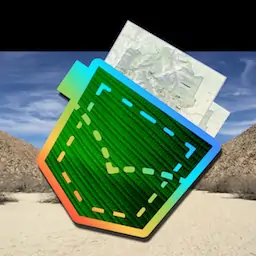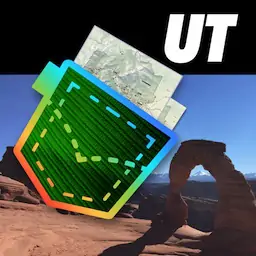by Alex Gugel , all rights reserved
Geologic FeaturesCapitol Reef |
Geologic Features of Capitol Reef National Park (NP) in Utah. Published by the National Park Service (NPS).
featured in
| National Parks Pocket Maps |  | |
| Utah Pocket Maps |  |
Capitol Reef National Park
National Park Service
U.S. Department of the Interior
Geologic Features of Capitol Reef
The powerful forces that created and shaped Capitol Reef’s
landscape have produced a wide variety of geologic features, large
and small. Within the Waterpocket Fold, many peculiar sights
attract the curiosity of park visitors. Each detail has its own history.
The stories combine to explain a unique collection of wonders.
Please help preserve these features for all to discover and enjoy.
Do not leave graffiti or other vandalism. Do not disturb or
collect rocks or other park resources.
Black Boulders
Black boulders found scattered throughout
the Fremont River valley and along other
drainages are recent geologic arrivals. These
volcanic rocks came from 20- to 25-millionyear-old lava flows that cap nearby Boulder
and Thousand Lakes mountains and areas
westward.
During the most recent Ice Age cycles, these
high plateaus supported small mountain
glaciers. The grinding action of the glaciers
eroded into the high hillsides, embedding
pieces of the andesitic lava plateaus within the
glacial ice. Numerous debris flows and glacial
outburst floods sent cascades of meltwater,
ice, and rocky debris tumbling from the
glaciers into the river valleys below. Pieces of
lava rock were transported many miles from
their source, and were smoothed and rounded
by their violent journeys within the gritty
floodwaters.
Rock Colors
Impurities in sedimentary rocks act as
pigments. Iron is the most common coloring
agent found in Capitol Reef’s rocks.
Yellow to orange to rusty brown rocks
contain limonite. Example: Navajo Sandstone.
Geothite, a mineral similar to limonite,
forms brown concretions. Example: Dakota
Sandstone.
Light blue, greenish-gray, and off-white
rocks show the true colors of the sedimentary
particles. Example: Shinarump Member of the
Chinle Formation.
Dark gray to brownish-gray to black rocks
contain incompletely-decomposed organic
matter preserved under conditions such as
Bridges and Arches
When floods receded, black boulders were left
scattered across the floodplains. These flood
deposits were left perched along valley slopes
as their respective canyons deepened with
continued erosion. This process reoccurred
many times over the past 150,000 years.
The deposits can still be observed today in
the valleys and canyons of Sulphur Creek,
Pleasant Creek, and the Fremont River.
The black boulders are black on the inside
too! The white coating on the surface of many
of the boulders is a mineral crust known as
caliche, which is mainly a thin film of calcite
and gypsum crystals. Caliche forms when
mineral-laden groundwater seeps upward,
coats the underside of the boulders, and
evaporates from the surface, leaving its
dissolved minerals behind.
stagnant marine basins. Example: Mancos
Shale.
Dark green rocks contain reduced iron,
and were deposited in marine basins,
swamps, bogs, and lakes. Example: Morrison
Formation.
Red to reddish-brown to purple rocks
contain hematite which is simple rust or iron
oxide. Example: Moenkopi Formation.
Bright white rocks may consist of gypsum.
Thin veins, deposited by groundwater
circulating through fractured bedrock,
are common in the Moenkopi and Carmel
Formations. Gypsum also occurs as clear
selenite crystals.
In geologic terms, “bridge” and “arch” both
refer to naturally occuring spans of stone. The
key difference lies in how the span forms.
Erosion by ice, water, wind, rockfall, and other
natural processes may combine to form and
sculpt bridges and arches. However, flowing
water, either a permanent or temporary
stream, is influential in sculpting a bridge
at some point during its formation. An arch
is formed by natural processes other than
flowing water.
Hickman Bridge
Solution Cavities
Solution cavities can be seen in many rock
surfaces at Capitol Reef. Also known as
tafoni or honeycomb weathering, these
concentrations of surface holes are caused by
the weathering effects of wind, water, and ice.
The cavities are only on the surface; that is,
there are no holes hidden within the rock layer
behind the surface.
What causes solution cavities to form in the
first place? Sandstone, in which the cavities
often form, is made of sand grains cemented
together with minerals, commonly calcite or
silica. Some of the sandstone may have areas
that are weakly cemented together, creating
softer rock. These soft areas erode easily
and more quickly when exposed to surface
weathering, creating cavities and leaving
behind harder portions of rock.
Excellent examples of solution cavities can be seen in
the walls of Capitol Gorge, and along the trail in the
upper reaches of Cohab Canyon (shown here).
Long after intermittent streams dry up in this
desert environment, waterpockets often serve
as precious sources of water for wildlife. Lush
vegetation may be seen growing around a
waterpocket, its water creating a small oasis of
life.
Also known as potholes, tanks, or tinajas,
waterpockets are depressions that form where
water erodes into solid bedrock (usually
sandstone).
The circulating action of flowing water, and
the abrasive sand and other debris it carries,
gradually wear away stone, often forming
circular holes along the stream channel. These
depressions often occur below waterfalls
and in steeper drainages where water flows
directly over smooth bedrock. Much of
the erosion takes place during flash floods
when large amounts of gritty water scour the
potholes. Loose rocks trapped within deeper
waterpockets act as scraping tools when
floodwaters stir them around, accelerating
the erosion and enlarging and deepening the
basins.
Please help preserve these delicate resources
by not polluting waterpockets. Swimming,
wading, bathing, or washing in waterpockets is
prohibited in Capitol Reef National Park.
The Waterpocket Fold, Capitol Reef’s defining geologic feature, was named for the
large number of waterpockets found in this area.
EXPERIENCE YOUR AMERICA™
www.nps.gov/care
NPS/Jacob Frank photo
Waterpockets
1/16


